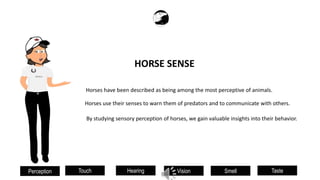
Horse Sense
- 1. Vision Hearing Touch Perception Smell Taste Horses have been described as being among the most perceptive of animals. By studying sensory perception of horses, we gain valuable insights into their behavior. Horses use their senses to warn them of predators and to communicate with others. HORSE SENSE BRENDA
- 2. Vision Hearing Touch Perception Smell Taste A horse is so sensitive to touch, on a single hair on their skin, a horse can sense a fly anywhere it lands on them, and twitch that particular muscle to get the fly off of them. The Sense Of Touch is Very Sensitive in a Horse Touch is the most direct form of communication between horses and people. It is important that people understand and be aware of how a horse responds to touch. Horses respond to pressure by moving away in a predictable response. From a horse’s skin, to their lips, their hair, their nose, and their muzzle, touch is their most acute sense. It is through their mouth and muzzle that horses use their sense of touch. The muzzle whiskers of a horse are extremely useful to help them navigate themselves around objects. Their whiskers help a horse estimate the distance between their muzzle and objects around them. Since a horse can’t see angles below their head, the whiskers help guide the horse and help the horse to explore and identify objects. Horses can pick up vibrations through their teeth and their hooves that are transmitted through the ground. This helps the horse be alert to predators.
- 3. Vision Hearing Touch Perception Smell Taste Horses can listen to more than one thing at a time. A Horse’s Hearing is Much Keener Than Ours The wind can confuse horses because they hear many sounds from so far away. It is believed that horses can hear sounds up to 2.5 miles away. They use their hearing for three primary functions: • To detect sounds. • To determine the location of the sound. • To provide sensory information that allows the horse to recognize the identity of these sources. Horses’ ears can move 180 degrees using 10 different muscles (vs. 3 for the human ear) and are able to single out a specific area to listen to. Horses can hear low to very high frequency sounds that are further away than people can hear.
- 4. Vision Hearing Touch Perception Smell Taste Always let a horse know when you approaching towards its blind spot A horse with the head held vertically will have binocular focus on objects near its feet. A horse can use binocular vision to focus on distant objects by raising its head A Horse’s Vision is it’s Primary Detector of Danger. Their ‘Binocular’ Vision (with both eyes) is directed down their nose straight ahead the horse actually has a blind spot in front of its forehead and limited vision behind. The Equine Eye is the one of the largest of any land mammals . A horse's eyes are located on either side of his head which is a big advantage for them as a prey animal as it offers a wide, circular view, meaning they can detect stalking animals sneaking up from behind. This panoramic vision is ‘Monocular' ('mono' meaning 'one') which enables them to view their surroundings on both sides, with either eye.
- 5. Vision Hearing Touch Perception Smell Taste Horses use their sense of smell to identify each other, people & predators. Horses use their sense of smell as a recognition tool Flehmen Response The large nostrils of the horse is designed to flare to gather more smells. They pick up scents around them acutely to find food, to smell predators, to lead themselves back home through their own scents of trails, to find mates, to socialize. Equines have a well developed sense of smell: • If a horse smells moldy or stale feed, it will refuse to eat. • If water smells different or the bucket the water is in smells odd to the horse, the horse won’t drink even if they are thirsty. They will drink out of a muddy puddle, because the water smells natural to them. • Horses can smell medication in their food even if it is masked in other treats.
- 6. Vision Hearing Touch Perception Smell Taste Horses have a well developed sense of taste. The Sense of Taste is Important for a Horse's Well Being Horses spend more of their time eating than to any other activity. How much time a horse spends eating is controlled by the amount of time they have to graze, type and availability of the plant. How much a horse eats and what they eat is very important to their productivity and well being. A horse’s taste buds can easily differentiate between bitter, sour, sweet and salty. Researchers know very little about horse’s sense of taste. What they do believe is that selective taste buds are designed to protect horses from ingesting toxic plants, and that may be the reason horses have an aversion to bitter tasting things.
